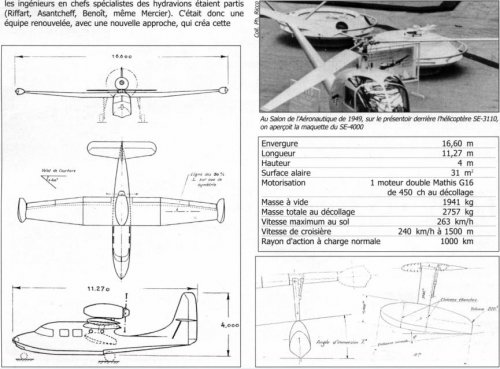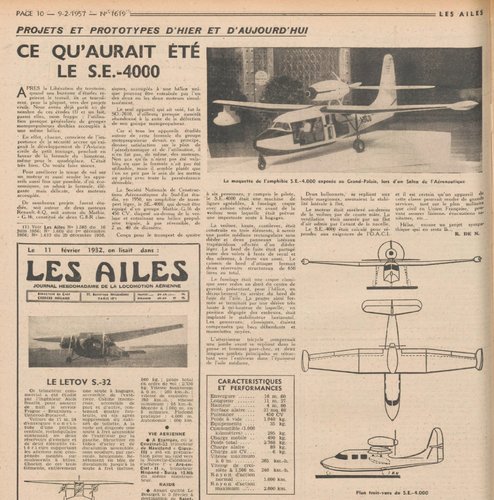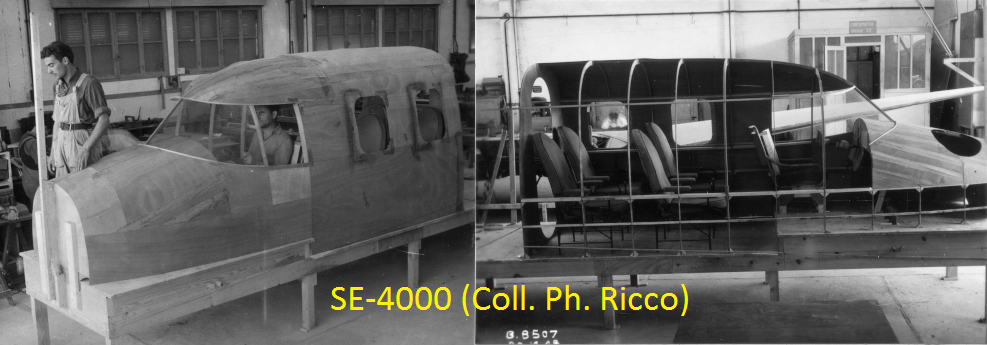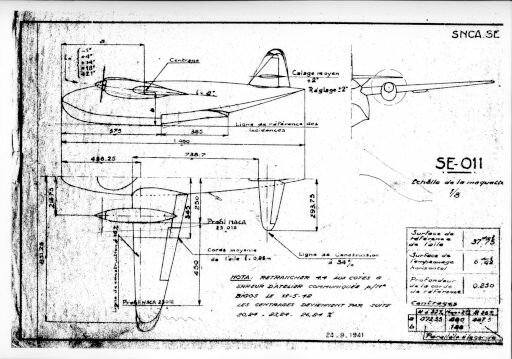You are using an out of date browser. It may not display this or other websites correctly.
You should upgrade or use an alternative browser.
You should upgrade or use an alternative browser.
SNCASE (Sud-Est) Postwar flying boat projects
- Thread starter Jemiba
- Start date
- Joined
- 30 November 2007
- Messages
- 1,126
- Reaction score
- 586
foiling said:Thanks for providing some information on this attractive project, Caravellarella.
Thank you Foiling. There is more information in this rather generic and disparate topic......
http://www.secretprojects.co.uk/forum/index.php/topic,841.0/highlight,sud+est+flying.html
which has an odd mix of references to pre-war types and even has the SNCAC NC.211 Cormoran heavy lift transport landplane thrown in for good measure ???
Terry (Caravellarella)
- Joined
- 26 May 2006
- Messages
- 34,872
- Reaction score
- 15,733
- Joined
- 27 December 2005
- Messages
- 17,744
- Reaction score
- 26,338
French flying boats. I cannot vouch for the accuracy of the drawings.
Tony.
Attachments
- Joined
- 26 May 2006
- Messages
- 34,872
- Reaction score
- 15,733
Hi,
anther two projects for SNCASE,the first was derivative of SE.200 as a 200 ton flying
boat,and the second was X.104,later was very similar to SE.4000.
Brochure réalisée pour la conférence de Vitrolles (juin 2013)
Les hydravions à Vitrolles
(de CAMS à la SNCASE)
anther two projects for SNCASE,the first was derivative of SE.200 as a 200 ton flying
boat,and the second was X.104,later was very similar to SE.4000.
Brochure réalisée pour la conférence de Vitrolles (juin 2013)
Les hydravions à Vitrolles
(de CAMS à la SNCASE)
Attachments
- Joined
- 26 May 2006
- Messages
- 34,872
- Reaction score
- 15,733
Jemiba said:Special thanks for that, Hesham !
Seems to be a larger version of the SE.4000 amphibian
(from Les Ailes via richard)
From AFM 07,the SNCASE SE.4000 Amphibian project.
Attachments
- Joined
- 26 May 2006
- Messages
- 34,872
- Reaction score
- 15,733
hesham said:Hi,
the SNCASE SE.4030 was high wing amphibian aircraft project,powered
by two Armstrong siddeley Cheetah or P&W engines.
http://www.flightglobal.com/PDFArchive/View/1951/1951%20-%201233.html?search=sikorsky%20helicopter%20project%201990
A small Info about SNCASE SE.4030.
http://www.avia-it.com/act/biblioteca/periodici/PDF%20Riviste/Alata/Alata%201951%20012.pdf
Attachments
- Joined
- 26 May 2006
- Messages
- 34,872
- Reaction score
- 15,733
Jemiba said:Chillon, Dubois and Wegg say in "French Postwar Transport Aircraft", that the
SE.1200 project started "in he late forties". The data they give for the Se.1200:
span 61m, lenght 47,9m, MTOW 140.000 kg with 22.000 payload, powered by 8
3000hp Arsena l24H, turboprops were considered. The SE.1300 is said to have
been another flying boat project, a direct relation to the 1200 isn't mentioned,
the only detail given is the MTOW of 180.000 kg. And no drawings .....
Lots of projects to explore !
Yes my dear Jemiba,
the SNCASE SE.1300 was a transatlantic flying boat Project,developed from SE.200,
and could carry a 167 passenger.
- Joined
- 26 May 2006
- Messages
- 34,872
- Reaction score
- 15,733
hesham said:hesham said:Hi,
the SNCASE SE.4030 was high wing amphibian aircraft project,powered
by two Armstrong siddeley Cheetah or P&W engines.
http://www.flightglobal.com/PDFArchive/View/1951/1951%20-%201233.html?search=sikorsky%20helicopter%20project%201990
A small Info about SNCASE SE.4030.
http://www.avia-it.com/act/biblioteca/periodici/PDF%20Riviste/Alata/Alata%201951%20012.pdf
A model for it;
http://www.letletlet-warplanes.com/2018/04/09/aerosalon-paris-1951/
Attachments
- Joined
- 26 May 2006
- Messages
- 34,872
- Reaction score
- 15,733
Attachments
- Joined
- 26 May 2006
- Messages
- 34,872
- Reaction score
- 15,733
What that a SNCASE SE.4030 or anther Project ?.

 www.boisgirard-antonini.com
www.boisgirard-antonini.com

SNCASE AMPHIBIE DE TRANSPORT. Dessin original... - Lot 187 - Boisgirard - Antonini
Toutes les informations sur le lot SNCASE AMPHIBIE DE TRANSPORT. Dessin original... - Lot 187 - Boisgirard - Antonini
Attachments
- Joined
- 30 November 2007
- Messages
- 1,126
- Reaction score
- 586
What that a SNCASE SE.4030 or anther Project ?.

SNCASE AMPHIBIE DE TRANSPORT. Dessin original... - Lot 187 - Boisgirard - Antonini
Toutes les informations sur le lot SNCASE AMPHIBIE DE TRANSPORT. Dessin original... - Lot 187 - Boisgirard - Antoniniwww.boisgirard-antonini.com
Breguet......
Terry (Caravellarella)
For the record, the 24H engines were developments of these series (Wikipedia, hmmmm)
That's how France hoped to get R-4360 class 4000 hp piston engines. Well... it didn't worked. At all. If you think the He-177 was bad, that was even worse.
I remember reading a Pierre Marie Gallois interview 20 years ago (he died in 2010).
This man > https://en.wikipedia.org/wiki/Pierre_Marie_Gallois
He was the one that turned the 1948 disasters (Armagnac, Cormoran, Espadon, VG-90...) into 1952 successes (Noratlas, Ouragan, Fouga Magister, Alouette III, Caravelle...). The 24H and other horrors, he had to get ride off in the first place.
He explained that in 1948 the french aviation industry had immense ambitions (not a bad thing per se) but still laid in ruins. Out of this dichotomy, only come disasters...
Moteurs d'avion
- Arsenal 12H : développement après guerre du moteur V12 Junkers Jumo 213.
- Arsenal 12H-Tandem : deux moteurs 12H en tandem avec hélices co-axiales.
- Arsenal 12K : poursuite du développement du 12H.
- Arsenal 24H : moteur à 24 cylindres en H utilisant les blocs cylindres du 12H, vilebrequins et pistons monté sur un nouveau carter entraînant une seule hélice.
- Arsenal 24H-Tandem : deux moteurs 24H en tandem avec hélices co-axiales.
That's how France hoped to get R-4360 class 4000 hp piston engines. Well... it didn't worked. At all. If you think the He-177 was bad, that was even worse.
I remember reading a Pierre Marie Gallois interview 20 years ago (he died in 2010).
This man > https://en.wikipedia.org/wiki/Pierre_Marie_Gallois
He was the one that turned the 1948 disasters (Armagnac, Cormoran, Espadon, VG-90...) into 1952 successes (Noratlas, Ouragan, Fouga Magister, Alouette III, Caravelle...). The 24H and other horrors, he had to get ride off in the first place.
He explained that in 1948 the french aviation industry had immense ambitions (not a bad thing per se) but still laid in ruins. Out of this dichotomy, only come disasters...
The Atar flying wings, the SO-4000 bomber, the 24H piston engine, that SE-1200, the PA-28 carriers and its three (abysmal) naval fighters - VG-90, NC-1080, three dead, NC-2200 "nobody killed but it was a dog" - great projects, for sure, but unrealistic and unaffordable in 1948 France, really.
Plus the relics from 1939 like the Late-631 and the Richelieu-class battleships, big and powerful symbols but perfectly obsoletes and unuseful and ruinous.
Plus the relics from 1939 like the Late-631 and the Richelieu-class battleships, big and powerful symbols but perfectly obsoletes and unuseful and ruinous.
taildragger
You can count on me - I won a contest
- Joined
- 2 November 2008
- Messages
- 404
- Reaction score
- 502
Some of the early postwar French projects were so unconventional that I've always suspected that they were intended more to keep the industry occupied as it was reassembled and soak up Marshall Plan funds than to produce service-ready designs.
Some of the early postwar French projects were so unconventional that I've always suspected that they were intended more to keep the industry occupied as it was reassembled and soak up Marshall Plan funds than to produce service-ready designs.
Mostly right (although disagreeing on marshall funds). In 1946 France had a communist aviation minister, Charles Tillon, not a bad man per se and who did his best to restart the aircraft industry at any cost - including vanity projects and ramping up production out of a ruined industry. He just went a bridge too far.

Charles Tillon - Wikipedia
The reality of the time however was (somewhat ironically) large scale production of German aircraft build under licence by Vichy France - they were continued after 1944. Problem was, they had been duly sabotaged by the resistance... and now this turned against post-war France. Still Tillon wanted 4000 aircraft by 1946-47.
Most of the German aircraft were trainers and transports and utility, with the notable exception of FW-190. It could have provided a decent combat aircraft but not only reliability was catastrophic, but they issued these birds to the... Normandie Niemen (Neu-Neu) squadron, who had fought these very FW with their Yak-9s now worn out (and paid a heavy death toll to the Germans).
Imagine the Neu-Neu pilots faces when they were told "you will trade your Yakovlev against FW."
As for the War in Indochina beginnings, in 1946 the Armée de l'Air had to scavenge Japanese Ki-43 aircraft before getting Spitfires (1947, wholly inadapted), P-63s (hardly better) and finally, Bearcats (at least, but by 1950 the game was already over). http://worldatwar.net/chandelle/v3/v3n1/frcoin.html
A major issue was the engines - pre-war french designs were obsolete and twice unreliable (1939 reliability was already pretty bad, 1945 did not helped) while german engines, too, got twin pains - late-war Germany low quality plus resistance sabotages.
A boatload of crashes happened as a result.
Meanwhile research on jet engines started unabated but it took time. Plus all the delays suffered by 4 years of occupation did not helped. What's worse, jet engines soon pushed toward the sound barrier and it was already a bloody and tedious affair for GB, USA and USSR - so imagine for France. Although the Espadon, by pure luck, was not a killer like the VG-90, it just climbed like a led brick because it was too heavy. So Vampire, Mistral and Ouragans kicked it out.
It is interesting to compare the fate of the first three jet fighters - Espadon, Vampire-Mistral and Ouragan.
Last edited:
- Joined
- 26 May 2006
- Messages
- 34,872
- Reaction score
- 15,733
What that a SNCASE SE.4030 or anther Project ?.

SNCASE AMPHIBIE DE TRANSPORT. Dessin original... - Lot 187 - Boisgirard - Antonini
Toutes les informations sur le lot SNCASE AMPHIBIE DE TRANSPORT. Dessin original... - Lot 187 - Boisgirard - Antoniniwww.boisgirard-antonini.com
I think it was not related to SE.4000 series,because they appeared in 1949/51,
and I think it was a SNCASE SE.1700,maybe ?.
Last edited:
- Joined
- 11 March 2006
- Messages
- 8,624
- Reaction score
- 3,792
hesham is right here, I think, so I moved that discussion to a dedicated thread, to be found here:
https://www.secretprojects.co.uk/threads/the-french-aviation-industry-1936-to-1940.32840/
So, back to post war flying boats, designed/built by SNCASE, please !
And just a reminder: Discussions generally run smoother, when adressing someone personally can
be avoided, especially in cases of different opinions ...
https://www.secretprojects.co.uk/threads/the-french-aviation-industry-1936-to-1940.32840/
So, back to post war flying boats, designed/built by SNCASE, please !
And just a reminder: Discussions generally run smoother, when adressing someone personally can
be avoided, especially in cases of different opinions ...
- Joined
- 11 March 2012
- Messages
- 3,247
- Reaction score
- 3,176
S.E.-4000 looks considerably larger and heavier than contemporary Republic Seabee(USA) or Trident Trigull (Canada) amphibians. Seabees started with an animic 195 hp. Franklin, but many were later converted to more powerful Lycoming or Continental engines, with the 300 hp. Corvette engine proving the best compromise between fuel consumption and power. Prototype Trigulls flew with Continental Tiara 6-285 engines, but never entered production.
That 450 horsepower Mathis G.-16 engine proved unreliable. It was a pair of 200 hp., V8 engines in tandem, turning a single propeller through a combining gearbox. SNCASO test flew a G.-16 engine in their SO.7010 prototype, but the project was doomed by engine problems.
When (circa Soloy test-flew a modified Cessna Caravan with a pair of coupled P&WC PT6A engines, the FAA refused to certify the conversion. Ironically, P&WC PT6A Twin Packs have proven successful on a variety of helicopters, most notably Bell Twin Hueys.
That 450 horsepower Mathis G.-16 engine proved unreliable. It was a pair of 200 hp., V8 engines in tandem, turning a single propeller through a combining gearbox. SNCASO test flew a G.-16 engine in their SO.7010 prototype, but the project was doomed by engine problems.
When (circa Soloy test-flew a modified Cessna Caravan with a pair of coupled P&WC PT6A engines, the FAA refused to certify the conversion. Ironically, P&WC PT6A Twin Packs have proven successful on a variety of helicopters, most notably Bell Twin Hueys.
- Joined
- 26 May 2006
- Messages
- 34,872
- Reaction score
- 15,733
The whole article.And from AFM03 magazine,
the SNCASE SE.1200.
Attachments
- Joined
- 15 February 2024
- Messages
- 500
- Reaction score
- 1,302
Similar threads
-
SNCASE (Sud-Est) SE.1200 helicopter project
- Started by hesham
- Replies: 3
-
-
-
-





























